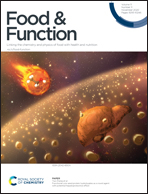Probiotics improved hyperlipidemia in mice induced by a high cholesterol diet via downregulating FXR
Abstract
Probiotics effectively regulated lipid metabolism and improved hyperlipidemia. The purpose of this study was to further evaluate the functions of lipid-lowering strains in vivo and elucidate the mechanism. The hyperlipidemia model was constructed using a high fat diet, and four lipid-lowering strains were selected for intervention. In the four strains, the strains Lactobacillus vaginalis FN3 (FN3) and Bifidobacterium animalis subsp. Lactis F1-7 (F1-7) reduced TG, TC and LDL and increased HDL. These two strains decreased TC and TC in the liver of high fat diet fed mice, and they increased total bile acids (TBA) in feces. F1-7 and FN3 reduced the mRNA levels of Farnesoid X Receptor (FXR), recombinant Fibroblast Growth Factor 15 (FGF 15) and Niemann-Pick C1-Like 1 (NPC1L1), and up-regulated the Liver X Receptor (LXR) mRNA level. They decreased the protein expressions of FXR and NPC1L1. In addition, F1-7 up-regulated the protein expression of cholesterol 7-alpha hydroxylase (CYP7A1). In summary, Bifidobacterium animalis subsp. Lactis F1-7 and Lactobacillus vaginalis FN3 could regulate bile acid metabolism by downregulating the FXR gene and reduce the absorption of exogenous cholesterol by regulating NPC1L1. F1-7 could also participate in the FXR/FGF15 pathway to improve hyperlipidemia, which showed better effects than FN3.



 Please wait while we load your content...
Please wait while we load your content...